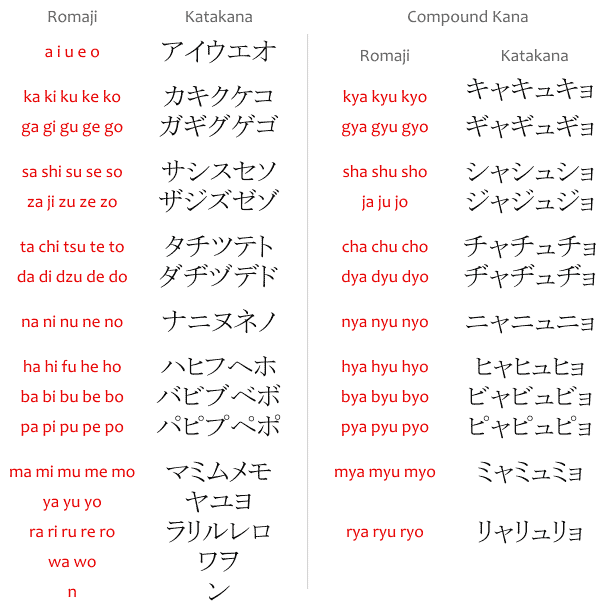The katakana 片仮名 is one of the three Japanese "alphabets". It's counterpart of the hiragana ひらがな. Both katakana and hiragana are sometimes referred to as kana かな.
Unlike the kanji 漢字, whose readings may vary depending on the word, the way a kana such as katakana is read always stay the same.
The katakana is normally used to write loan-words, foreign (non-Japanese) names, onomatopoeic and mimetic words, the readings of kanji and words in online dictionaries, and to indicate speech sounds off (e.g. mispronounced, or badly pronounced, like a robot talking) in manga. Aesthetically, it looks cooler than the other "alphabets."
Chart
For reference, the romaji chart including only the katakana:
| a ア |
i イ |
u ウ |
e エ |
o オ |
| ka カ |
ki キ |
ku ク |
ke ケ |
ko コ |
| ga ガ |
gi ギ |
gu グ |
ge ゲ |
go ゴ |
| sa サ |
shi シ |
su ス |
se セ |
so ソ |
| za ザ |
ji ジ |
zu ズ |
ze ゼ |
zo ゾ |
| ta タ |
chi チ |
tsu ツ |
te テ |
to ト |
| da ダ |
di ヂ |
dzu ヅ |
de デ |
do ド |
| na ナ |
ni ニ |
nu ヌ |
ne ネ |
no ノ |
| ha ハ |
hi ヒ |
fu フ |
he ヘ |
ho ホ |
| ba バ |
bi ビ |
bu ブ |
be ベ |
bo ボ |
| pa パ |
pi ピ |
pu プ |
pe ペ |
po ポ |
| ma マ |
mi ミ |
mu ム |
me メ |
mo モ |
| ya ヤ |
yu ユ |
yo ヨ |
||
| ra ラ |
ri リ |
ru ル |
re レ |
ro ロ |
| wa ワ |
n ン |
wo ヲ |
Some notes:
- The layout above is called gojūon 五十音, "fifty sounds," although it's only really fifty without diacritics.
- Different romaji systems have different romaji for the same kana, e.g. フ is fu in some systems, hu in others.
- zi-di-zu-dzu シヂズヅ, known as yotsugana 四つ仮名, are pronounced identically in some regions of Japan.
- The small a-i-u-e-o ァィゥェォ may be used to mark long vowels.
- The small tsu ッ may be used to mark geminate consonants.
- The small ke ヶ isn't a katakana but a symbol instead.
- vu ヴ, u ウ with dakuten 濁点, is a syllable found only in foreign words, meaning that, in practice, it's as if it had no hiragana counterpart, as hiragana isn't normally used to write foreign words.
Next you have the diphthongs (compound kana) spelled using the small kana ゃゅょ.
| kya キャ |
kyu キュ |
kyo キョ |
| gya ギャ |
gyu ギュ |
gyo ギョ |
| sha シャ |
shu シュ |
sho ショ |
| ja ジャ |
ju ジュ |
jo ジョ |
| cha チャ |
chu チュ |
cho チョ |
| dya ヂャ |
dyu ヂュ |
dyo ヂョ |
| nya ニャ |
nyu ニュ |
nyo ニョ |
| hya ヒャ |
hyu ヒュ |
hyo ヒョ |
| bya ビャ |
byu ビュ |
byo ビョ |
| pya ピャ |
pyu ピュ |
pyo ピョ |
| mya ミャ |
myu ミュ |
myo ミョ |
| rya リャ |
ryu リュ |
ryo リョ |
For reference, as an image:

I love the way this form looks, with all the sharp edges they remind me of a razor sharp katana blade. ^_^ As you also described the others in your section of how hiragana looks chummy and kanji look serious.
ReplyDeleteHowever certain ones always confuse me such as -shi, so, tsu and n. Most places do not give the "lip" or "tail" and just make a curved line, followed by one or two dashes like- " or ' . Here and how I write them, they always have that little extra to help to determine which is which. How exactly are you suppose to know otherwise? I try to look for differences, but when they are not in order of the alphabet, I have a hard time distinguishing between them. I think there might be a small curve that forms at one end or the other, but hardly noticeable to me.
"No" is not hard to figure out, because it is the only one not have a "tick" mark and is the odd one out. (I know they are called something else, but for lack of a better term I hope you can understand.)